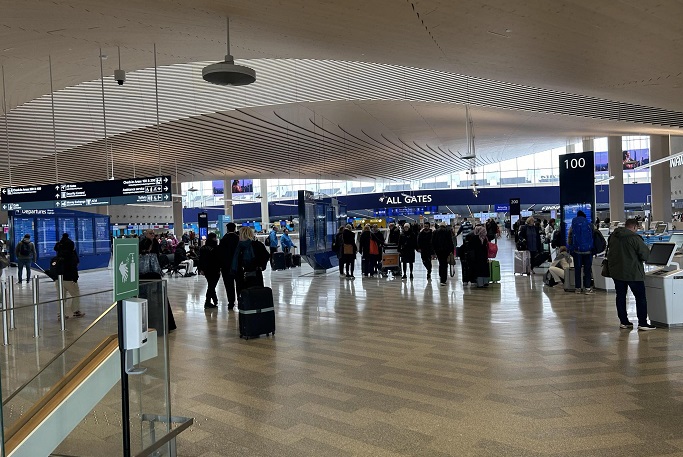Finland sees 2nd weakest air traffic growth in Europe
Published : 16 Jul 2024, 02:20
Recovery of Finland's air connectivity has been the second weakest in Europe compared to the pre-pandemic level in 2019, according to a recent report by Airport Council International (ACI).
In practice, Finland’s total air connectivity has decreased by 37% compared to the level before the COVID-19 pandemic, said country´s airports operator Finavia in a press release on Monday referring to the ACI report.
Total air connectivity measures direct routes and routes with onward connecting flights.
The growth of Slovenia was at the bottom of the list (-29%) followed by Czechia, Austria and Finland (-28%).
In January–June 2024, a total of 9.4 million passengers (+4.2%) passed through Finavia’s 20 airports.
Of this figure, 7.7 million passed through Helsinki Airport (+3.6%).
Despite the increase in the number of passengers in the first half of 2024, Finnish air traffic has recovered very poorly to the 2019 level compared to other countries in Europe.
In addition to geopolitics, changes in travel habits have also had an impact on the recovery.
"In air traffic, Finland is moving in the opposite direction compared to the rest of the Eurozone. Compared to other European airports, the recovery of passenger volumes at Helsinki Airport in particular has been slower than average. The situation of Finnish air traffic is particularly affected by geopolitics: Due to the effects of the Russian airspace ban, there are significantly fewer flights to Asia and there have been 45% fewer passengers on Asian routes than in 2019," said Petri Vuori, Finavia’s Senior Vice President responsible for route development.
In Europe, air connectivity has recovered very unevenly. This is due to the fact that the reason for travel is increasingly leisure travel.
This change in travel habits will increase air connectivity in Europe, especially to tourism-oriented countries. For example, Greece (+22%) and Portugal (+4%) have already exceeded the 2019 level in terms of their air connectivity level.
Passenger numbers from Helsinki Airport to Mediterranean destinations are on the rise, driven by tourism.
In the first half of 2024 passenger numbers on flights to Greece increased by +12.7%, to Spain by +5.7% and to Italy by +3.5% compared to the same period last year.
In June 2024 passenger numbers to Italy have increased by +15.8%, to Greece by +9% and to Spain by +6,7% compared to June 2023.
"Leisure travel is increasingly driving travel. This global trend can also be seen in Finland. Based on passenger data from Helsinki Airport, Finns still want to travel to Mediterranean destinations in the summer," said Vuori.
Despite the steady growth, passenger numbers have only recovered to about 70% of the 2019 level.
Of the reference airports, Arlanda Airport in Stockholm, for example, recovered to 87% of the 2019 level in January–June 2024 (Swedavia).
In the first half of the year, 1.6 million passengers (+6.9%) travelled via Finavia’s 19 regional airports.
The increase in passenger numbers was driven by Lapland’s record winter tourism season: almost 900,000 passengers passed through Rovaniemi, Ivalo, Kittilä and Kuusamo airports alone (+16%).
This amounts to 55% of all passengers at Finavia’s regional airports.
"The increase in passenger numbers at Lapland airports reflects a global trend where the reason for travelling is increasingly leisure travel. On the other hand, business travel in Europe has decreased or increasingly shifted to rail. The growing popularity of train travel is particularly evident in domestic travel in Europe. For example, domestic air travel has decreased in Germany by 52% and in Sweden by 38% since 2019. Our assessment is that the reduction in business travel has been significantly influenced by the increase in remote work and meetings as well as the stricter travel policies of organisations," Vuori added.
This trend is particularly evident in Finland at airports where the reason for travelling has traditionally been business travel.
In Finland, Oulu Airport is one of the traditional business travel airports. The airport's passenger numbers have recovered to only 52% of the 2019 level.
Similarly, Turku has recovered to 59% and Vaasa to 55% of the 2019 level.
Excluding Lapland airports, a total of 735,616 passengers (minus 2%) travelled via Finavia’s regional airports. This amounts to a 46% decrease compared to the same period in 2019.
The phenomenon can also be observed at the five Finavia regional airports that receive scheduled flights subsidised by the Finnish state.
In the first half of 2019, a total of 210,692 passengers travelled via the airports of Joensuu, Jyväskylä, Kajaani, Kemi-Tornio and Kokkola-Pietarsaari. In January–June 2024, the number was 80,237 ( minus 62%).


